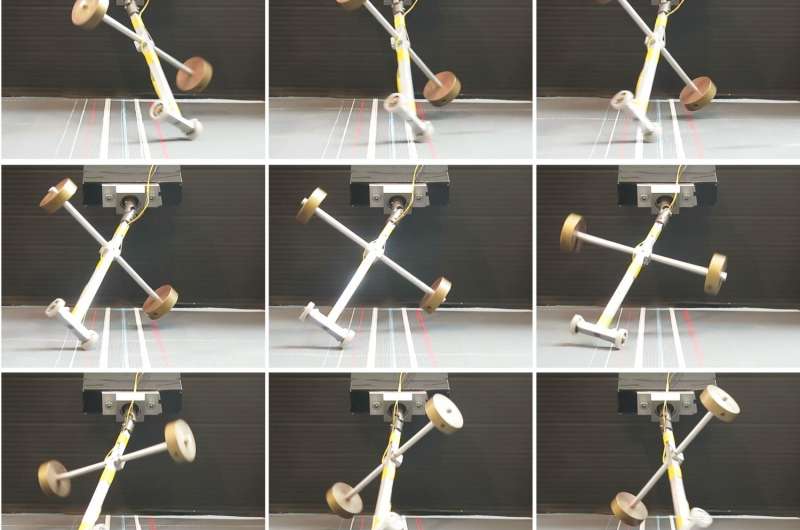June 21, 2017 report
Problem of wheeled suitcases wobbling explained

(Phys.org)—A team of researchers at Universite Paris-Diderot has uncovered the reason for wobbling of wheeled suitcases. In their paper published in Proceedings of the Royal Society A, the group explains the physics behind suitcase wobbling and offer some suggestions to overcome the problem.
Most people who travel these days use a suitcase with wheels that allow for pulling it around rather than carrying it. While the new approach does make it easier to lug a suitcase, it has become clear such luggage suffers from a serious problem—wobble. Sometimes, while a suitcase is being wheeled, it starts to wobble back and forth—and in some cases, it progresses to actually tipping over. As the researchers with this new effort note, the natural reaction is to slow down—but that is actually not the best option, they report after conducting experiments with model suitcases in their lab. The suitcase problem is a reminder that not all physics problems are complicated.
To learn more about what happens with wheeled suitcases, the researchers placed a model suitcase on a treadmill and watched what happened. They discovered that if one of the wheels encountered an obstacle such as a small bump, it jumped into the air for just a moment and then banged back down to the ground. That second action caused the opposite wheel to lift off the ground and then to bang back down, causing the first to lift again and so on. This oscillation increases, the researchers found, as the suitcase is pulled forward. Eventually, it overturns. It happens, the group found, because the two wheels are on a fixed rod and because of the force exerted by the person pulling.
The researchers also found that the best way to slow the oscillations is to increase the speed at which the suitcase is being pulled—this gives the suitcase less time between each wheel rising and falling, preventing the oscillations from growing stronger. Reducing the angle of the suitcase can help too, they note, which means lowering the handle toward the ground, though it seems that attempting to apply both remedies simultaneously would require some degree of athleticism.
More information: The rolling suitcase instability: a coupling between translation and rotation, Proceedings of the Royal Society A (2017). rspa.royalsocietypublishing.or … .1098/rspa.2017.0076
Abstract
A two-wheel suitcase or trolley can exhibit undamped rocking oscillations from one wheel to the other when pulled fast enough. We study this instability both experimentally—with a toy model of a suitcase rolling on a treadmill—and theoretically. The suitcase oscillates only if a finite perturbation is applied. This is because intrinsic dissipation occurs when the supporting wheel switches. When unstable, the suitcase either increasingly rocks until overturning or reaches a stable limit cycle. The friction force at the rolling wheels constrains wheels to roll without slipping. This constraint imposes a coupling between the translational motion and the three-dimensional rotational motion of the suitcase that drives the rocking instability. The same behaviours are observed in the experiments and in the simulations. The asymptotic scaling laws we observe in the simulations are explained by means of a simplified model where the coupling force is explicit.
Journal information: Proceedings of the Royal Society A
© 2017 Phys.org




















